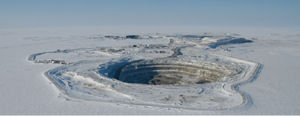Canada's Diamond Future
May 03, 08 by
By Martin Irving
Canada is now firmly established as a “top five” rough diamond producer. The first wave of production, between 1998 and 2003, included the two world-class diamond mines, Ekati and Diavik, which continue to provide the bulk of Canada’s production. The second wave, with production beginning between 2006 and 2008 includes the disappointing Jericho mine, and De Beers Canada’s first two mines in Canada: Snap Lake and Victor. The third wave will likely begin production between 2011 and 2013, and should include Gahcho Kué (51 percent De Beers Canada, 49 percent Mountain Province Diamonds), Star Kimberlite (100 percent Shore Gold) and Renard (50 percent Stornoway, 50 percent Soquem).
Now speculators and analysts are assessing various projects and companies to determine which ones are most likely to be part of the fourth wave from Canada, beginning production perhaps between 2014 and 2016. While this may be too far into the future for some, it is not really that far away. It is surprising how quickly six to eight years can pass; after all, Supplier of Choice is already eight years old.Before examining the subject, a brief discussion of “Diamond Exploration 101” is in order. The exploration process for diamonds varies but generally begins with prospecting, which involves surface sampling of dirt, gravel and tills. Thousands of samples may be taken to undergo geochemical analyses and processing. Hopefully, clues within the samples will focus exploration toward locations that can be drilled, after which drill samples (in the ten to 100 kilogram range) will be taken and analyzed.
If positive, mini bulk samples (100-500 tons) will be taken, either from the surface or through large drilling programs. If the results from the mini bulk samples are positive, then a large bulk sample, sufficient to provide more than 5,000 carats of diamonds, will be taken. At this point, an economic model can be developed that will assess the cost of mining the deposit versus the revenues based on carats per ton and dollars per carat. This process, needless to say, takes time, and on properties with several potential targets, different stages of the process can overlap, with mini bulk samples being done on one target and drilling on another.
Of the numerous diamond exploration projects underway across Canada, there are three that I am watching with interest.
Orion is the name given to the string of kimberlites just north of the Star kimberlite in central Saskatchewan.
The project, also referred to as the Fort a la Corne joint venture, is 60 percent owned by Shore Gold and 40 percent by Newmont (one of the largest gold mining companies in the world). The project is likely to develop into additional open pits and to be processed through the mill constructed for the Star kimberlite mine. It will not be a “new” mine, but it has the potential to result in the doubling of production from the Star mine. If the Star mine moves forward in a timely manner, and the bulk sampling of the various Orion kimberlites are successful, production in the 2013-2014 timeframe is conceivable.
| 
Image Courtesy of Diavik Diamond Mines Inc. |
The kimberlite field of the Buffalo Hills area of northern Alberta was discovered in the 1990s. It is the third largest kimberlite field in Canada (after Lac de Gras and the Fort a la Corne fields). To date, a total of 38 kimberlites have been discovered in the region, of which 26 are diamondiferous. The property is owned by Diamondex (22.5 percent), Shore Gold (22.5 percent), Encana Corporation (43 percent) and Pure Diamonds Exploration Inc. (12 percent). Diamondex is the operator of the project, and Shore Gold and Diamondex can increase their combined ownership from 45 percent to 72.5 percent through funding exploration over the next few years. Six kimberlite pipes that have been mini bulk sampled since 1997 have returned grades of between 7.2 carats per hundred tons (cpht) and 55 cpht. Further drilling and bulking sampling over the next few years will provide a better understanding of the real economic potential of the property. The property location, relatively close to existing infrastructure, is a positive element of determining the economics of the property.
The Churchill property is on the western shore of Hudson Bay, located close to tidewater, which should simplify development and reduce costs as the project moves forward. The property is owned by Shear Minerals (58.14 percent) and Stornoway Diamonds (41.86 percent). More than 50 kimberlites have been identified on the property, and exploration is focusing on a system of kimberlite dykes. The Kahuna dyke has been mini bulk sampled and has returned an overall diamond grade of 0.95 carats per ton (or 95 carats per hundred tons). Drill samples from other dykes have returned values of 29 to 138 diamonds per kilogram. Further drilling (to determine the size of the dyke) and bulk sampling will be undertaken this year.
| 
Image Courtesy of Diavik Diamond Mines Inc.
|
In addition to the good exploration results to date, all of these properties are located in areas with existing infrastructure, or close to tidewater, unlike the current high-cost Canadian diamond mines. Location and available existing infrastructure are critical in assessing the economic viability of a project. The existing Canadian mines are high-cost mines that are viable because of their significant grade and/or the value of their diamonds. Given the increase in the Canadian dollar, and the increasing costs of constructions (as the prices of steel and other commodities increase) and operations (fuel and so on), new mines in Canada will either have to be world-class deposits (like Ekati and Diavik) or have reduced costs due to location and available infrastructure.
|  |
After 10 years in government managing the diamond file, Martin Irving is now the principal of diamond consultants Canada, providing strategic and business advice and support to and about the Canadian diamond industry. he can be contacted at www.diamondconsultants.ca.ca or mirving[at]sasktel[dot]net



